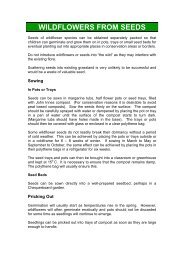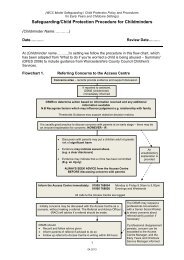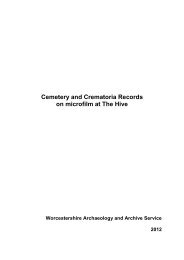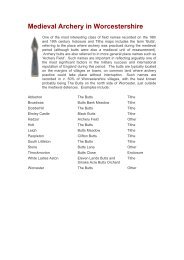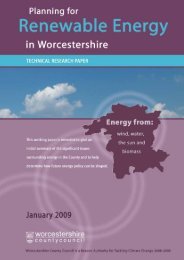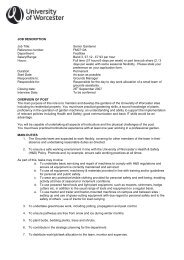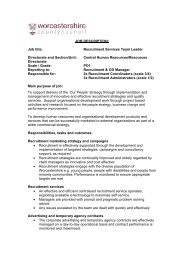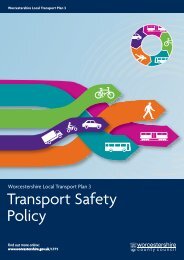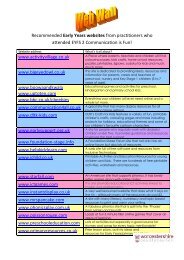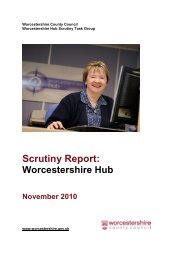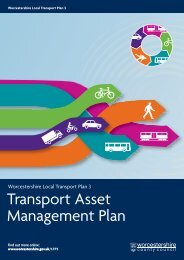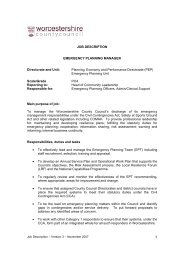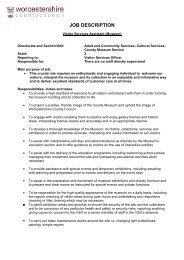Walking and Public Realm Policy - Worcestershire County Council
Walking and Public Realm Policy - Worcestershire County Council
Walking and Public Realm Policy - Worcestershire County Council
You also want an ePaper? Increase the reach of your titles
YUMPU automatically turns print PDFs into web optimized ePapers that Google loves.
<strong>Worcestershire</strong> Local Transport Plan 3<br />
<strong>Worcestershire</strong> Local Transport Plan 3<br />
<strong>Walking</strong> <strong>and</strong> <strong>Public</strong><br />
<strong>Realm</strong> <strong>Policy</strong><br />
Find out more online:<br />
www.worcestershire.gov.uk/LTP3
1.1.1 <strong>Worcestershire</strong>’s <strong>Walking</strong> & <strong>Public</strong> <strong>Realm</strong> <strong>Policy</strong> provides the strategic framework for the<br />
development of measures which will help to make journeys on foot safer, easier <strong>and</strong> more<br />
pleasant <strong>and</strong> ensure that the public realm – the public spaces within which most transport<br />
activities take place – provides appropriate space for the many competing uses <strong>and</strong> improves the<br />
quality of the built environment.<br />
1.1.2 This policy document sets out the <strong>Worcestershire</strong> <strong>County</strong> <strong>Council</strong> policy on the delivery of<br />
<strong>Walking</strong> & <strong>Public</strong> <strong>Realm</strong> measures <strong>and</strong>, along with the other LTP3 policy documents, supersedes all<br />
previous documentation published by <strong>Worcestershire</strong> <strong>County</strong> <strong>Council</strong> on the subject. The<br />
document sets out the technical processes underpinning the delivery of <strong>Walking</strong> & <strong>Public</strong> <strong>Realm</strong><br />
measures. This policy document will be treated as a live document, <strong>and</strong> so will be updated over<br />
time in response to changing economic, social environmental <strong>and</strong> technological advances.<br />
1.1.3 <strong>Walking</strong> as a mode of transport is used as a means to an end (for everyday access to employment,<br />
education, shops, healthcare <strong>and</strong> other day-to-day activities) <strong>and</strong> as an end in itself for walking as<br />
a recreational activity. It can form the sole mode of transport from origin to destination; however<br />
it also forms part of nearly every other journey made, for example between the house <strong>and</strong> train<br />
station or from cycle st<strong>and</strong> to the traveller's final destination.<br />
1.1.4 One advantage over many other modes is the more extensive <strong>and</strong> permeable network of routes<br />
available for use. This is not limited to footways alongside roads; it includes for example the<br />
extensive countywide <strong>Public</strong> Rights of Way network covering urban <strong>and</strong> rural areas, canal<br />
towpaths, short-cuts in residential estates <strong>and</strong> routes across public open spaces (The rural, usually<br />
unsurfaced, parts of the <strong>Public</strong> Rights of Way Network are covered in a separate LTP3 Rights of<br />
Way Improvement Plan <strong>Policy</strong>).<br />
1.1.5 The <strong>Public</strong> <strong>Realm</strong> is comprised of the streets, roads, squares, village greens <strong>and</strong> open spaces<br />
between buildings which are accessible to the public, whether in public or private ownership. As<br />
well as providing routes for travel, places to unload <strong>and</strong> park vehicles, they also have important<br />
roles to play as places which people visit, meet in, enjoy <strong>and</strong> undertake daily activities.<br />
1.1.6 The functions of the public realm also include: a workplace <strong>and</strong> retail location (with street<br />
markets), entertainment location (with fairs <strong>and</strong> community events) <strong>and</strong> eating place (with<br />
outdoor seating for restaurants, cafes <strong>and</strong> pubs) <strong>and</strong> provides the setting for many of the county's<br />
most important historic buildings. Good quality public realm encourages people to stay longer<br />
<strong>and</strong> enjoy a place, with increased footfall having consequent benefits for the tourism economy.<br />
The quality of the public realm is very much affected by the presence, location <strong>and</strong> design of<br />
street furniture – everything from bridges to street lighting <strong>and</strong> direction signs, but also including<br />
non-functional items, for example public art.<br />
1.1.7 All of these roles need to be balanced within a constrained amount of space. There are clear links<br />
to several other LTP3 strategies – including those covering the separate transport modes, on<br />
freight, parking <strong>and</strong> the Transport Asset Management Plan. There are significant links to the work<br />
undertaken by partner organisations, including the spatial planning <strong>and</strong> urban design undertaken<br />
by the <strong>Worcestershire</strong> Borough, City <strong>and</strong> District <strong>Council</strong>s.
1.2.1 The combined problems of traffic congestion, environmental pollution, carbon emissions <strong>and</strong><br />
public health give significant reasons to adopt policies which promote walking. In addition, the<br />
business case for <strong>and</strong> affordability of major new highway construction as a sustainable long-term<br />
solution becomes more difficult, there is a growing need to adopt policies that make better use<br />
of existing assets.<br />
1.2.2 <strong>Walking</strong> <strong>and</strong> <strong>Public</strong> <strong>Realm</strong> measures are the tools by which local transport authorities encourage<br />
more journeys to be made on foot, making use of the existing walking network, as well as adding<br />
to it. Measures to improve the public realm support a wide range of objectives which include<br />
transport but also embraces heritage protection, spatial planning <strong>and</strong> the quality of the built <strong>and</strong><br />
natural environments.<br />
1.3.1 The purpose of the <strong>Worcestershire</strong> <strong>Walking</strong> & <strong>Public</strong> <strong>Realm</strong> <strong>Policy</strong> is to set out the processes <strong>and</strong><br />
approach required to establish the suitable walking network <strong>and</strong> facilities which will address the<br />
needs of both current <strong>and</strong> potential future users in <strong>Worcestershire</strong> <strong>and</strong> deliver the transport<br />
objectives of the Government <strong>and</strong> <strong>Worcestershire</strong> <strong>County</strong> <strong>Council</strong>.<br />
1.3.2 The starting point for this <strong>Worcestershire</strong> <strong>Walking</strong> & <strong>Public</strong> <strong>Realm</strong> <strong>Policy</strong> is the overall socioeconomic<br />
objectives of LTP3, which have been developed to reflect national <strong>and</strong> local policy,<br />
which are outlined in Table 1.1.<br />
1.3.3 The <strong>Worcestershire</strong> <strong>Walking</strong> & <strong>Public</strong> <strong>Realm</strong> <strong>Policy</strong> must also support the <strong>Worcestershire</strong><br />
Sustainable Community Strategy (WSCS) which includes the following six themes, all of which are<br />
influenced by the performance <strong>and</strong> availability of transport infrastructure <strong>and</strong> services:<br />
Communities that are safe <strong>and</strong> feel safe;<br />
A better environment for today <strong>and</strong> tomorrow;<br />
Economic success that is shared by all;<br />
Improving health <strong>and</strong> well being;<br />
Meeting the needs of children <strong>and</strong> young people; <strong>and</strong><br />
Stronger Communities (including housing, culture, poverty <strong>and</strong> volunteering).<br />
1.3.4 Table 1.1 identifies how the <strong>Worcestershire</strong> <strong>Walking</strong> & <strong>Public</strong> <strong>Realm</strong> <strong>Policy</strong> will contribute towards<br />
achieving the wider socio-economic objectives of the LTP3 <strong>and</strong> <strong>Worcestershire</strong> Sustainable<br />
Community Strategy.
Table 1.1 – The <strong>Walking</strong> & <strong>Public</strong> <strong>Realm</strong> <strong>Policy</strong> <strong>and</strong> How It Will Deliver Against <strong>Worcestershire</strong> Local<br />
Transport Plan 3 <strong>and</strong> Sustainable Community Strategy Objectives<br />
To support<br />
<strong>Worcestershire</strong>'s<br />
economic<br />
competitiveness <strong>and</strong><br />
growth through<br />
delivering a reliable<br />
<strong>and</strong> efficient<br />
transport network<br />
To reduce the<br />
impacts of transport<br />
in <strong>Worcestershire</strong> on<br />
the<br />
local<br />
environment, by<br />
reducing noise <strong>and</strong><br />
transport-related<br />
emissions of carbon<br />
dioxide <strong>and</strong> other<br />
greenhouse gases,<br />
with the desired<br />
outcomes of tackling<br />
climate change <strong>and</strong><br />
reducing the impacts<br />
of transport on<br />
public health<br />
Economic success<br />
that is shared by<br />
all<br />
Stronger<br />
Communities<br />
A better<br />
environment for<br />
today <strong>and</strong><br />
tomorrow<br />
<strong>Walking</strong> can bring business benefits as a healthier,<br />
more active workforce means reduced<br />
absenteeism <strong>and</strong> increased productivity. It acts as<br />
an important connector mode to enable travellers<br />
to access bus <strong>and</strong> rail services <strong>and</strong> transfer<br />
between modes.<br />
<strong>Walking</strong> enables access to local employment,<br />
shops <strong>and</strong> services <strong>and</strong> is very reliable in terms of<br />
journey time. Mode shift from car trips to walking<br />
reduces congestion, which can improve journey<br />
time reliability for all road users.<br />
<strong>Walking</strong>, applied with a strategic area-based<br />
approach, can make a significant contribution to<br />
reducing transport's carbon emissions <strong>and</strong> climate<br />
change impacts. It does not involve the use of<br />
carbon-emitting vehicles <strong>and</strong> will not directly be<br />
affected by concerns of peak oil production.<br />
Meanwhile, public realm improvements can often<br />
provide ways of mitigating against climate change,<br />
such as tree planting for shade in warmer<br />
temperatures <strong>and</strong> as 'carbon sinks', or as part of<br />
flood prevention schemes.<br />
To contribute<br />
towards better<br />
safety, security,<br />
health <strong>and</strong> longer<br />
life-expectancy in<br />
<strong>Worcestershire</strong>, by<br />
reducing the risk of<br />
death, injury or illness<br />
arising from transport<br />
<strong>and</strong> promoting<br />
healthy modes of<br />
travel<br />
Communities that<br />
are safe <strong>and</strong> feel<br />
safe<br />
<strong>Walking</strong> measures applied strategically can enable<br />
people to choose a mode of travel that requires<br />
physical activity <strong>and</strong> helps incorporate exercise into<br />
their daily routine, helping to combat heart disease<br />
<strong>and</strong> obesity. <strong>Walking</strong> <strong>and</strong> public realm measures can<br />
help ensure that walking environment is a pleasant<br />
place to travel through, spend time in <strong>and</strong> feels safe,<br />
which can contribute to a person's wellbeing. By<br />
virtue of their visibility on the street, more people<br />
walking more often can help create a virtuous cycle<br />
which encourages others to take up the mode more<br />
often.
To optimise equality<br />
of opportunity for all<br />
of <strong>Worcestershire</strong>'s<br />
citizens with the<br />
desired outcome of<br />
creating a fairer<br />
society.<br />
To enhance the<br />
quality of life for<br />
<strong>Worcestershire</strong>'s<br />
residents by<br />
promoting a healthy,<br />
natural environment,<br />
conserving our<br />
historic built<br />
environment <strong>and</strong><br />
preserving our<br />
heritage assets<br />
Stronger<br />
Communities<br />
Meeting the<br />
needs of children<br />
<strong>and</strong> young people<br />
Improving health<br />
<strong>and</strong> well being;<br />
Where <strong>Walking</strong> <strong>and</strong> <strong>Public</strong> <strong>Realm</strong> measures are<br />
applied using a strategic, area-based approach,<br />
accessibility can be provided to key local facilities<br />
<strong>and</strong> the severance caused by roads, railways <strong>and</strong><br />
rivers is reduced, allowing participation in society.<br />
Relative to other modes, walking involves little<br />
cost <strong>and</strong> can be the most suitable for younger<br />
<strong>and</strong> older people wishing to be independently<br />
active <strong>and</strong> to whom other modes are not realistic<br />
options. <strong>Public</strong> <strong>Realm</strong> measures can ensure that<br />
less mobile citizens – including those using<br />
wheelchairs <strong>and</strong> mobility scooters have less<br />
difficulty in negotiating the streets – <strong>and</strong> that all<br />
members of society have pleasant places for<br />
social interaction <strong>and</strong> community events.<br />
<strong>Walking</strong> <strong>and</strong> <strong>Public</strong> <strong>Realm</strong> measures applied<br />
strategically can lead to journeys transferring<br />
from other, more polluting or environmentally<br />
damaging modes. This leads to a reduction in<br />
congestion <strong>and</strong> noise pollution, <strong>and</strong><br />
improvements in air quality <strong>and</strong> environmental<br />
quality overall.<br />
<strong>Walking</strong> <strong>and</strong> <strong>Public</strong> <strong>Realm</strong> measures can help citizens<br />
access the natural environment <strong>and</strong> preserve <strong>and</strong><br />
enhance the setting of the county's historic built<br />
environment <strong>and</strong> ensure quality of life in residential<br />
areas.<br />
To enhance the<br />
quality<br />
of<br />
<strong>Worcestershire</strong>'s<br />
Transport Asset,<br />
through sensitive <strong>and</strong><br />
appropriate design<br />
with the desired<br />
outcome of reducing<br />
the costs <strong>and</strong><br />
inconvenience of<br />
maintenance works<br />
Stronger<br />
Communities<br />
The use of <strong>Walking</strong> <strong>and</strong> <strong>Public</strong> <strong>Realm</strong> measures can<br />
significantly enhance the efficiency of constrained<br />
transport networks by transferring journeys away<br />
from the congested highway network. In doing so,<br />
the need to construct <strong>and</strong> maintain additional<br />
highway infrastructure is significantly reduced.<br />
<strong>Walking</strong> <strong>and</strong> <strong>Public</strong> <strong>Realm</strong> measures therefore can<br />
have a strong role to play in reducing overall asset<br />
maintenance costs in <strong>Worcestershire</strong>. However, a<br />
balance must be found between raising the quality<br />
of the built environment against the costs of<br />
maintaining new <strong>and</strong> existing <strong>Walking</strong> <strong>and</strong> <strong>Public</strong><br />
<strong>Realm</strong> schemes to minimise ongoing maintenance<br />
costs.
1.3.5 The target audience for this policy includes a wide range of stakeholders comprising the<br />
representatives of the residents of <strong>Worcestershire</strong>, highway network users (across all modes of<br />
transport), voluntary groups, the Department for Transport, local authority partners, rail <strong>and</strong> bus<br />
users <strong>and</strong> operators, Network Rail, taxi <strong>and</strong> private hire users <strong>and</strong> operators, the Highways Agency<br />
<strong>and</strong> regulatory bodies. To be thorough <strong>and</strong> robust, this policy document by necessity covers a<br />
wide range of, often technical, issues. The level of technical detail is necessary to ensure the<br />
document is precise <strong>and</strong> unambiguous.<br />
1.4.1 In line with the objectives identified above, the specific objectives of this <strong>Walking</strong> & <strong>Public</strong> <strong>Realm</strong><br />
management policy will be to:<br />
Maximise the role of walking for utility <strong>and</strong> recreational trips in tackling congestion,<br />
improving public health, combating climate change, enhancing local accessibility <strong>and</strong><br />
addressing social exclusion;<br />
Improve safety <strong>and</strong> security for pedestrians <strong>and</strong> reduce pedestrian/vehicle conflicts;<br />
Ensure that the walking network is safe, pleasant <strong>and</strong> convenient to use;<br />
Create <strong>and</strong> maintain a public realm of quality streets <strong>and</strong> open spaces where a diverse set of<br />
transport, economic, social <strong>and</strong> community roles can take place.<br />
1.5.1 The implementation of a strategic <strong>Walking</strong> <strong>and</strong> <strong>Public</strong> <strong>Realm</strong> <strong>Policy</strong> will deliver against the<br />
outcomes of the <strong>Worcestershire</strong> LTP3 Compendium <strong>and</strong> the <strong>Worcestershire</strong> Sustainable<br />
Community Strategy to:<br />
Enhance economic activity by maximising accessibility to key services <strong>and</strong> facilities<br />
Make travel by all modes more efficient (safer, less polluting, quicker <strong>and</strong> cheaper);<br />
Encourage more sustainable, responsible travel choices<br />
Promote safer, more responsible use of constrained transport networks<br />
1.5.2 In particular, the aim of this <strong>Walking</strong> & <strong>Public</strong> <strong>Realm</strong> <strong>Policy</strong> is to clarify <strong>Worcestershire</strong> <strong>County</strong><br />
<strong>Council</strong>'s approach to implementing walking <strong>and</strong> public realm measures.<br />
1.6.1 This <strong>Worcestershire</strong> LTP3 <strong>Walking</strong> & <strong>Public</strong> <strong>Realm</strong> <strong>Policy</strong> has been developed to be fully compliant<br />
with all current <strong>and</strong> relevant National <strong>and</strong> Local <strong>Policy</strong>. A summary of these policies is provided in<br />
the LTP3 Overarching <strong>Policy</strong> <strong>and</strong> Dem<strong>and</strong> Document.<br />
1.6.2 In particular, this document is aligned with the emerging Core Strategies which have been<br />
produced by the <strong>Worcestershire</strong> Borough, City <strong>and</strong> District <strong>Council</strong>s.
2.1.1 The <strong>Worcestershire</strong> <strong>Walking</strong> & <strong>Public</strong> <strong>Realm</strong> <strong>Policy</strong> has a central role to play in the delivery of the<br />
LTP3 objectives as identified in Table 1.1. This policy considers the strategic application of <strong>Walking</strong><br />
& <strong>Public</strong> <strong>Realm</strong> measures in <strong>Worcestershire</strong>.<br />
2.2.1 <strong>Worcestershire</strong> has made significant progress towards encouraging walking, through infrastructure<br />
enhancements <strong>and</strong> improved information. As part of the Worcester 'Choose how you move'<br />
project <strong>and</strong> wider LTP2 activities, <strong>Worcestershire</strong> <strong>County</strong> <strong>Council</strong> has developed a range of<br />
walking maps for the majority of <strong>Worcestershire</strong>'s urban areas, <strong>and</strong> has installed a number of<br />
directional signs, which indicate both walk times <strong>and</strong> distances to key trip attractors.<br />
2.2.2 Many of the infrastructure improvements to the walking network have been delivered as part of a<br />
partnership approach with the <strong>Worcestershire</strong> Borough, City <strong>and</strong> District <strong>Council</strong>s <strong>and</strong> user<br />
groups. This approach works well <strong>and</strong> delivers best value.<br />
<strong>Worcestershire</strong> <strong>County</strong> <strong>Council</strong> will work in partnership with key partners, including the<br />
<strong>Worcestershire</strong> Borough, City <strong>and</strong> District <strong>Council</strong>s, private sector partners <strong>and</strong> those<br />
representing disability groups, to create <strong>and</strong> maintain a walking network <strong>and</strong> wider public<br />
realm which:<br />
caters for all groups of people, including less mobile pedestrians, those with sight or<br />
hearing impairments <strong>and</strong> who use mobility scooters or wheelchairs;<br />
is free from obstructions, including parked vehicles, <strong>and</strong> minimises barriers to access;<br />
is permeable <strong>and</strong> legible, with appropriate levels of signage where necessary;<br />
is clean, attractive <strong>and</strong> comfortable;<br />
is safe to use;<br />
maximises directness, minimises unnecessary deviation or delay <strong>and</strong> pays regard to<br />
pedestrians’ desire lines; <strong>and</strong><br />
is where possible includes routes which are shorter or quicker than the equivalent<br />
journeys by car.<br />
Particular attention will be paid to the quality of routes to key destinations, such as schools,<br />
colleges, employment sites, town centres, public transport interchanges <strong>and</strong> healthcare<br />
facilities <strong>and</strong> addressing accident cluster sites.<br />
Parts of the walking network, particularly in urban areas, will be reviewed in line with best<br />
practice guidelines when funding permits to ensure the network meets users' needs.
2.3.1 A poorly maintained pedestrian network, including elements such as litter, dog mess <strong>and</strong><br />
overhanging branches all act as deterrents to walking <strong>and</strong> impacts on the quality of the public<br />
realm.<br />
2.3.2 <strong>Worcestershire</strong>'s footways are placed into two categories according to their strategic importance<br />
<strong>and</strong> their level of use. Class 1 footways are the busiest footways <strong>and</strong> are mainly located in city <strong>and</strong><br />
town centres, whilst Class 2 covers all other less busy footways, mainly in residential areas <strong>and</strong><br />
villages.<br />
<strong>Worcestershire</strong> <strong>County</strong> <strong>Council</strong> will work in partnership with the Borough, City <strong>and</strong> District<br />
<strong>Council</strong>s <strong>and</strong> other bodies, including parish councils, to maintain a safe <strong>and</strong> clean walking<br />
network <strong>and</strong> public realm. Factors including the level of its use <strong>and</strong> its strategic importance<br />
will help resources to be prioritised.<br />
2.4.1 Winter maintenance is essential to ensure that paths remain passable, particular in sub-zero<br />
temperatures. Further details of <strong>Worcestershire</strong> <strong>County</strong> <strong>Council</strong>'s winter maintenance programme<br />
are provided in the <strong>Worcestershire</strong> Transport Asset Management Plan.<br />
The <strong>County</strong> <strong>Council</strong> will undertake a winter maintenance programme which takes account of<br />
the needs of pedestrians <strong>and</strong> where appropriate <strong>and</strong> stocks allow, heavily-used off-road<br />
paths will be salted.<br />
2.5.1 <strong>Worcestershire</strong> has an extensive rights of way network, covering everything from shortcuts in<br />
urban areas to tracks through fields <strong>and</strong> across the Malvern Hills. The Countryside & Rights of Way<br />
Act 2000 gave the <strong>County</strong> <strong>Council</strong> a statutory duty to prepare a Rights of Way Improvement Plan,<br />
which has an emphasis on countryside routes. The <strong>Worcestershire</strong> Rights of Way Improvement<br />
Plan is included as a contingent part of the <strong>Worcestershire</strong> LTP3 Compendium. Elements of the<br />
rights of way network within urban areas, which are usually paved, are covered as part of this<br />
policy.<br />
2.6.1 The quality of the public realm, particularly in our towns <strong>and</strong> cities is vital if we are to be<br />
successful in creating environments that people want to live <strong>and</strong> work in. It represents an<br />
important element of the county’s network of green infrastructure. This is particularly the case for<br />
areas of deprivation <strong>and</strong> decline, where investment, proper maintenance, ongoing stewardship<br />
<strong>and</strong> restoration of civic pride are needed to raise st<strong>and</strong>ards in the public realm.
<strong>Worcestershire</strong> <strong>County</strong> <strong>Council</strong> will seek to work with partners to develop <strong>and</strong> manage the<br />
county's public realm in a sensitive <strong>and</strong> sustainable way, balancing its duties of giving due<br />
regard to needs of all highway users (including parking <strong>and</strong> loading), with conserving <strong>and</strong><br />
enhancing l<strong>and</strong>scape, townscape, biodiversity <strong>and</strong> heritage assets. It will take account of the<br />
diverse non-transport roles the public realm plays <strong>and</strong> consider local context <strong>and</strong><br />
distinctiveness.<br />
The <strong>County</strong> <strong>Council</strong> will seek to provide a public realm which is both robust <strong>and</strong> functional as<br />
well as being distinctive, attractive <strong>and</strong> which helps to preserve the county's historic character.<br />
This will be essential to develop <strong>Worcestershire</strong>'s economy, particularly as a centre for<br />
sustainable tourism.<br />
Maintaining, managing <strong>and</strong> improving the public realm will reflect best practice <strong>and</strong> will<br />
2.7.1 The involve location integrated of new working developments with partner is an essential organisations, determinant such as of the whether city, borough future district residents <strong>and</strong> <strong>and</strong><br />
visitors parish will councils choose <strong>and</strong> to West walk Mercia to access Police. the site. In particular, ensuring that new developments are<br />
well connected to existing pedestrian networks <strong>and</strong> any proposed public realm is in keeping with<br />
both existing <strong>and</strong> future environments. Specific guidance is provided in the <strong>Worcestershire</strong><br />
<strong>County</strong> <strong>Council</strong> Highway's Design Guide for New Developments.<br />
<strong>Worcestershire</strong> <strong>County</strong> <strong>Council</strong> will continue to work closely with the <strong>Worcestershire</strong><br />
Borough, City <strong>and</strong> District <strong>Council</strong>s <strong>and</strong> developers to ensure that new developments:<br />
Are located to maximise pedestrian accessibility to local facilities;<br />
Are designed to maximise permeability <strong>and</strong> legibility for pedestrians, <strong>and</strong> minimise<br />
delays to journeys on foot;<br />
Are designed to maximise natural surveillance on pedestrian routes; <strong>and</strong><br />
Make suitable financial contributions towards improvements to the local public realm<br />
<strong>and</strong> pedestrian networks.<br />
2.8.1 For pedestrians, crossing roads can be a source of delay, danger <strong>and</strong> difficulty to completing their<br />
journey on foot. This can be particularly the case for young road users, those with mobility<br />
impairments <strong>and</strong> on busy roads. In addition, the crossing may not be on the shortest route to the<br />
final destination – often referred to as the pedestrian's 'desire line'.<br />
2.8.2 A number of types of crossing types have been provided to help pedestrians cross roads,<br />
including zebra crossings, signal crossings, central pedestrian refuges <strong>and</strong>, less commonly, bridges<br />
<strong>and</strong> underpasses. In some places 'courtesy crossings', where vehicle drivers are encouraged to give<br />
priority to crossing pedestrians have also been introduced, particularly in urban areas. There are<br />
benefits <strong>and</strong> disbenefits of each of these types of crossing.
<strong>Worcestershire</strong> <strong>County</strong> <strong>Council</strong> will continue to provide appropriate types of crossing<br />
facilities for pedestrians in locations where it can be demonstrated that the number of<br />
pedestrian movements, volume <strong>and</strong> speed of traffic <strong>and</strong> cost of installation <strong>and</strong> maintenance<br />
justifies the installation of a particular type of crossing.<br />
Where formal pedestrian crossings are required, it is the county council's general policy to<br />
provide at-grade crossings on pedestrian desire lines wherever it is possible <strong>and</strong> safety<br />
considerations allow it.<br />
The <strong>County</strong> <strong>Council</strong> will seek to minimise pedestrian wait times at crossings, especially in<br />
locations where it is a priority mode in the hierarchy <strong>and</strong> ensure that the width of crossings<br />
are suitable for the number of pedestrians using them.<br />
2.9.1 <strong>Worcestershire</strong> has a number of locations where underpasses <strong>and</strong> footbridges have historically<br />
been provided to segregate pedestrians from road traffic. However, many pedestrians associate<br />
underpasses <strong>and</strong> subways with crime <strong>and</strong> graffiti <strong>and</strong> consequently avoid using them. They also<br />
end up being unloved places with poor environmental quality. Both underpasses <strong>and</strong> footbridges<br />
can take longer to use than if there was an equivalent at-grade crossing.<br />
The provision of grade separated pedestrian/cycle crossings (such as underpasses, subways<br />
<strong>and</strong> foot bridges) will in general be avoided by <strong>Worcestershire</strong> <strong>County</strong> <strong>Council</strong>, except where<br />
the volume <strong>and</strong> speed of traffic renders alternative, at-grade options unsafe.<br />
As funding is made available, <strong>Worcestershire</strong> <strong>County</strong> <strong>Council</strong> will seek to remove such existing<br />
infrastructure <strong>and</strong> replace it with at-grade alternatives. Where appropriate, interim measures<br />
to improve the attractiveness <strong>and</strong> lighting of subways will be considered.<br />
Where a grade-separated crossing is required, <strong>Worcestershire</strong> <strong>County</strong> <strong>Council</strong> will generally<br />
prefer the provision of bridges, on account of the personal safety, lighting <strong>and</strong> flooding issues<br />
associated with underpasses <strong>and</strong> subways.<br />
2.10.1 Pedestrian guard railings are used to guide pedestrians away from dangerous crossing locations<br />
<strong>and</strong> can be an effective road safety tool. However, they narrow the footway, prevent pedestrians<br />
crossing when <strong>and</strong> where they judge the road to be clear to do so <strong>and</strong> can be ugly. Current<br />
research indicates that its effectiveness may be limited to relatively few locations; consequently a<br />
balance must be found for their use which neither discourages pedestrian trips nor endangers<br />
pedestrian safety.
<strong>Worcestershire</strong> <strong>County</strong> <strong>Council</strong> will provide pedestrian guard railings only at locations where it<br />
can be demonstrated that its provision is necessary to provide safety benefits that could not<br />
be provided by other means. The <strong>County</strong> <strong>Council</strong> will review the need for retaining or<br />
removing existing guard railings on a case-by-case basis, particularly in urban areas, where<br />
guard railings can add to street clutter <strong>and</strong> cause severance.<br />
Dropped kerbs, particularly in urban areas, are vital to enable wheelchair users <strong>and</strong> other mobility<br />
impaired people to cross the road where vehicular crossings, which also permit this, are absent<br />
<strong>and</strong> make many other pedestrians’ journeys easier. However they will not achieve maximum<br />
benefit if they are placed away from the pedestrians’ desired route or where visibility of traffic is<br />
reduced.<br />
<strong>Worcestershire</strong> <strong>County</strong> <strong>Council</strong> will continue to work towards providing a comprehensive<br />
network of dropped kerbs on the footway network <strong>and</strong> will wherever possible place them to<br />
minimise deviation from a pedestrians’ preferred route.<br />
Where installed, dropped kerbs must leave no up-st<strong>and</strong> between footway <strong>and</strong> carriageway<br />
levels.<br />
2.12.1 Some highways, particularly in rural areas, do not have separate footways, which require<br />
pedestrians to walk in the carriageway. Whilst in many cases this occurs on lightly-trafficked roads<br />
<strong>and</strong> does not pose an unacceptable safety risk, there may be instances where it is appropriate to<br />
provide new footways.<br />
<strong>Worcestershire</strong> <strong>County</strong> <strong>Council</strong> will consider the requirement for new footways where none<br />
currently exist. They will be considered against factors such as the volume <strong>and</strong> speed of<br />
vehicles, the current <strong>and</strong> potential number of pedestrians, requirements to access to local<br />
facilities <strong>and</strong> bus stops, costs of provision <strong>and</strong> whether alternative, more appropriate<br />
measures could be introduced.<br />
2.13.1 Pedestrians have to share the footway with a wide variety of street furniture <strong>and</strong> traffic<br />
equipment. This street furniture can cause obstruction <strong>and</strong> this make the footway congested <strong>and</strong><br />
difficult to negotiate, especially for the mobility impaired or those with wheelchairs or pushchairs.<br />
The quantity of street furniture requires ongoing maintenance to prevent it detracting from the<br />
visual quality of the street.
<strong>Worcestershire</strong> <strong>County</strong> <strong>Council</strong> will seek to minimise the quantity of street furniture,<br />
consistent with the need for safety <strong>and</strong> suitable information provision. Where possible,<br />
decluttering exercises will include community involvement in street audits to identify the<br />
status <strong>and</strong> utility of existing infrastructure, assisting the decluttering process.<br />
Street furniture of historic interest will generally be retained <strong>and</strong> preserved in situ, whilst<br />
redundant or unnecessary items will be identified <strong>and</strong> removed. Those items of street<br />
furniture which are required should be carefully located to preserve pedestrian circulation<br />
space <strong>and</strong> they should provide more than one function (for example, signs attached to lamp<br />
columns) where possible. In particular, the design of street furniture will be specifically<br />
considered to ensure that it respects the character of the local area.<br />
2.14.1 The type of paving material chosen will affect the comfort of pedestrians, determine the cost of<br />
maintenance <strong>and</strong> can contribute to the visual quality of the streetscape. Because of the costs of<br />
keeping a wide range of paving in stock, <strong>Worcestershire</strong> <strong>County</strong> <strong>Council</strong> will seek to st<strong>and</strong>ardise<br />
the types of paving used across the county, as this will assist in making timely repairs <strong>and</strong> ensuring<br />
that the quality of paved surfaces is maintained. <strong>Worcestershire</strong> <strong>County</strong> <strong>Council</strong> recognises that<br />
quality materials that are installed properly can reduce the long-term maintenance costs <strong>and</strong> can<br />
enhance the streetscape, leading to attractive environments that support high quality of life <strong>and</strong><br />
stimulate economic activity.<br />
2.14.2 The <strong>Worcestershire</strong> LTP3 Transport Asset Management Plan (TAMP) policy document details the<br />
approach to be taken to st<strong>and</strong>ardising materials <strong>and</strong> ensuring materials are selected which are<br />
appropriate to the location in which they will be applied.<br />
<strong>Worcestershire</strong> <strong>County</strong> <strong>Council</strong> will choose appropriate materials <strong>and</strong> surfaces for footways,<br />
footpaths <strong>and</strong> other areas where pedestrians have priority which help ensure that it is easy<br />
<strong>and</strong> safe for pedestrians to negotiate, cost-effective to maintain <strong>and</strong> replace <strong>and</strong> provides an<br />
attractive setting which is suitable for the surrounding environment.<br />
The <strong>County</strong> <strong>Council</strong> will in general retain, conserve <strong>and</strong> restore <strong>and</strong> recycle historic footway<br />
surfaces. In choosing appropriate materials it will have regard to the need to protect, conserve<br />
<strong>and</strong> enhance the county's heritage <strong>and</strong> l<strong>and</strong>scape assets.
2.15.1 Street lighting allows road users to see <strong>and</strong> be seen. However, it is not appropriate in all locations,<br />
especially in sparsely populated rural areas where artificial lighting could be counter to the<br />
statutory l<strong>and</strong>scape designations. It also represents a significant ongoing energy cost for<br />
<strong>Worcestershire</strong> <strong>County</strong> <strong>Council</strong> <strong>and</strong> requires careful control, to avoid light spillage into the night<br />
sky <strong>and</strong> glare for residents. Further information on Street Lighting is included in the<br />
<strong>Worcestershire</strong> LTP3 Transport Asset Management Plan.<br />
<strong>Worcestershire</strong> <strong>County</strong> <strong>Council</strong> will provide adequate street lighting commensurate with the<br />
role of the transport route <strong>and</strong>, where applicable, in line with statutory requirements. The<br />
<strong>County</strong> <strong>Council</strong> will strive to save energy costs from its street lighting stock, in terms of<br />
equipment used <strong>and</strong> using dimming during the early hours of the morning where this would<br />
not compromise road user safety.<br />
2.16.1 Tree planting in the public realm gives various benefits <strong>and</strong>, along with parks, gardens <strong>and</strong> other<br />
vegetated open spaces are important parts of the county’s green infrastructure. They provide<br />
shade <strong>and</strong> shelter for the pedestrian, visual interest <strong>and</strong> screening in the l<strong>and</strong>scape, help mitigate<br />
the effects of noise <strong>and</strong> air pollution, a habitat for fauna <strong>and</strong> can act as a natural traffic calming<br />
device. Despite their benefits, there can sometimes be difficulties in reconciling street trees with<br />
accommodating underground utilities, the passage of tall vehicles, safety concerns <strong>and</strong> the<br />
damage to footway surfaces. Some of <strong>Worcestershire</strong>'s Borough, City <strong>and</strong> District <strong>Council</strong>s<br />
already have detailed documents on trees, which this policy seeks to reinforce.<br />
<strong>Worcestershire</strong> <strong>County</strong> <strong>Council</strong> recognises the benefits of street trees. It will continue to<br />
regularly survey its stock of street trees to ensure they do not pose a risk to road users <strong>and</strong><br />
that even footways are maintained. If trees must be removed due to disease, old age or other<br />
reasons, a suitable replacement will be planted. Additional street trees of a species suitable to<br />
the location will usually be considered as part of public realm improvements. (See the<br />
<strong>Worcestershire</strong> LTP3 Transport Asset Management Plan for further details on Street Trees).
2.17.1 Market stalls, trader's stock displayed on the footway outside shops <strong>and</strong> seating outside cafes,<br />
pubs <strong>and</strong> restaurant generally adds vibrancy to the street or provides natural surveillance, which<br />
helps deter crime <strong>and</strong> contribute to the county's economy.<br />
2.17.2 A-boards or s<strong>and</strong>wich boards are used by businesses to advertise their services. They are however<br />
often unsightly, obstruct the footway <strong>and</strong> can endanger pedestrians, particularly partially sighted<br />
or blind pedestrians.<br />
<strong>Worcestershire</strong> <strong>County</strong> <strong>Council</strong> will work with the district licensing authorities to ensure that<br />
market stalls <strong>and</strong> shops displaying stock on the footway are suitably permitted in locations<br />
which neither hinder pedestrian movement nor cause unreasonable nuisance to other highway<br />
users or frontagers <strong>and</strong> continue to be regulated <strong>and</strong> enforced.<br />
Advertising boards placed on the highway, including footways, without permission are illegal<br />
<strong>and</strong> <strong>Worcestershire</strong> <strong>County</strong> <strong>Council</strong> will use its powers to remove <strong>and</strong> dispose of them.<br />
Applications for outdoor seating at cafes, pubs <strong>and</strong> restaurants will be permitted where the<br />
county council is satisfied that:<br />
the footway width is sufficient to accommodate both the seating area <strong>and</strong> the main<br />
lines of pedestrian movement; <strong>and</strong><br />
the users of the seating area will not cause unreasonable nuisance to nearby<br />
frontagers <strong>and</strong> other highway users.<br />
2.18.1 Other than its functions for movement, streets are sometimes used for events such as festivals,<br />
fairs, parades <strong>and</strong> street parties, which often contribute to a sense of community <strong>and</strong> provide<br />
tourism income. These require a temporary traffic regulation order to close specific parts of the<br />
highway <strong>and</strong> ensure that legitimate access <strong>and</strong> diversions are in place.<br />
<strong>Worcestershire</strong> <strong>County</strong> <strong>Council</strong> will in principle look favourably on applications to hold<br />
community events on the highway <strong>and</strong> will work closely with West Mercia Police to ensure<br />
that applications to temporarily close roads are considered on their merits. They will need to<br />
be satisfied that:<br />
street frontagers have been canvassed for their opinion;<br />
certain categories of road user (e.g. bus passengers) will not be disproportionately<br />
inconvenienced; <strong>and</strong><br />
measures have been put in place to ensure legitimate access is retained <strong>and</strong> diversion<br />
routes are available.
2.19.1 Canals <strong>and</strong> rivers often have paths that run alongside them. In the case of managed waterways,<br />
these are generally in good condition <strong>and</strong> offer continuous, traffic-free routes which link urban<br />
areas together. <strong>Worcestershire</strong> <strong>County</strong> <strong>Council</strong> currently works with key providers, such as British<br />
Waterways <strong>and</strong> riverside owners to optimise access to these paths such that they perform an<br />
integrated role in walking (<strong>and</strong> cycling) networks.<br />
2.20.1 The speed of passing vehicles is a common safety concern of pedestrians. This topic is addressed<br />
in the LTP3 Transport Safety <strong>Policy</strong>.<br />
2.21.1 <strong>Worcestershire</strong>'s commitment during LTP2 to the Choose how you move programme, which<br />
sought to inform residents about their travel choices (particularly by sustainable modes) has<br />
demonstrated the value of promotion <strong>and</strong> information in encouraging more cost-effective,<br />
efficient <strong>and</strong> sustainable transport choice. <strong>Worcestershire</strong> <strong>County</strong> <strong>Council</strong> has embraced the<br />
results of this programme in the LTP3 Smarter Choices <strong>Policy</strong>, which sets out how <strong>Worcestershire</strong><br />
<strong>County</strong> <strong>Council</strong> will promote travel choice in future.<br />
2.22.1 Information on modal (user) hierarchies is set out in the LTP3 Traffic <strong>and</strong> Parking Management<br />
policy.
<strong>Worcestershire</strong> You can contact Local us in Transport the following Plan ways: 3<br />
For further information please contact:<br />
By telephone:<br />
01905 765765<br />
By post:<br />
<strong>Worcestershire</strong> <strong>County</strong> <strong>Council</strong>, <strong>County</strong> Hall, Spetchley Road, Worcester WR5 2NP<br />
DRAFT<br />
By email:<br />
worcestershirehub@worcestershire.gov.uk<br />
Online:<br />
www.worcestershire.gov.uk/LTP3<br />
This document can be made available in other formats (large print, audio tape, computer disk <strong>and</strong> Braille) on request.<br />
<strong>Worcestershire</strong> Local Transport Plan 3<br />
To the best of our knowledge all information was correct at the time of printing: March 2011.<br />
54547 07/10<br />
Find out more online:<br />
www.worcestershire.gov.uk/LTP3



